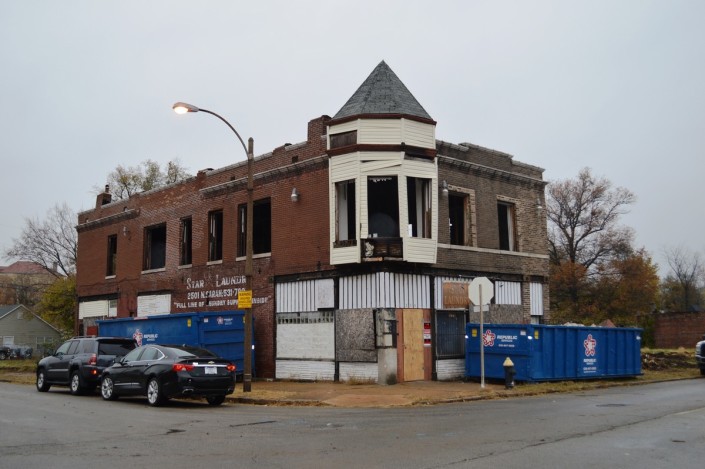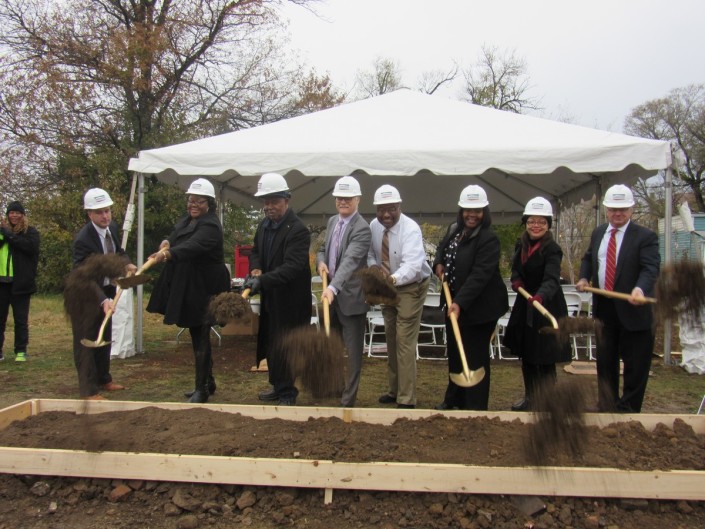The Ville Neighborhood has been top of mind lately.
Having a son who plays high school soccer, I've been to fields all over St. Louis and the small towns of North County to witness games. There is something special about Sumner High School. The areas surrounding it to the immediate north and east are stunning.
There is something special about parts of the Ville, still to this day. I've been poking around this city for years now and there are certain spots I come back to and just feel the place. The Ville around Sumner is one of those places, something strangely spiritual, can't put my finger on it. But, this part of the city is a beautiful place even after so many up and left.
So, I was happy to read a July, 2017 St. Louis Post-Dispatch article outlining a $7.1M plan to bring new and renovated homes to the Ville:
“Northside Community Housing, a community development corporation focused on the Ville, is leading the project along with Rise Community Development. Its proposal calls for nine new buildings on land owned by St. Louis’ land bank and the rehab of three existing structures near the intersection of St. Ferdinand Avenue and North Sarah Street, including the old Star Laundry building.
It’s the second phase of housing development in the area just west of the former Homer G. Phillips Hospital (now apartments) and Sumner High School. Around 2008, Northside Community Housing built dozens of single-family homes in the area. This phase, expected to break ground in September and take about a year, will be multi-family and include community space in the Star Laundry building that will be used for financial education classes and other programs.”
Then in November, 2017, NextSTL reported on the project with new numbers and more specifics including the following:
“Plans for 43 new and renovated housing units in the Ville will be one step closer to fruition once the city’s Planning Commission approves zoning changes this Wednesday. Northside Community Housing is partnering with Rise Community Development on the $10.3 million development at North Sarah and St. Ferdinand Ave about half a mile north of McCormack Baron Salazar’s successful North Sarah redevelopment.”
I knew this had to be a top twenty announcement for 2017...might be #1. I can't think of a more deserving neighborhood for attention, investment and preservation. The history here is awe-inspiring and vital to our city.
Most of these new homes will be built on vacant lots of former homes and businesses. Here's a screenshot of the corner of North Sarah and St. Ferdinand:
Google Street View Image - North Sarah and St. Ferdinand
Per Rise:
“Northside Community Housing, Inc. (NCHI) hosted a groundbreaking on November 15, 2017, at 2505 North Sarah Street, St. Louis, MO, 63113, at 9 AM. St. Ferdinand Homes II continues the revitalization of the Ville and Greater Ville neighborhood, replacing 13 derelict buildings and multiple vacant lots with 9 new buildings and 3 rehabbed buildings. Rise is providing consulting assistance to NCHI for the project. The development will consist of 36 new and 7 fully renovated mixed-income apartments and townhomes along with a new street front office space. NCHI is collaborating with the Metropolitan Sewer District (MSD) to incorporate onsite green infrastructure and rainscaping features as part of MSD’s Project Clear initiative. NCHI has developed 301 rental, lease-purchase, and for sale homes, including 87 homes adjacent to St. Ferdinand Homes II.”
- photo credits - RISE
I'm well aware of the history of this neighborhood, how black people were confined to certain parts of the city through deed restrictions, redlining and other racist policies.
Always dreaming and trying to empathize with the migratory patterns and decisions people made when the pulled out St. Louis roots and replanted in the suburbs, I've come to terms with migration. People generally want more and new things...bigger, newer, modern things. They want to look at their lives and say they did better than their parent's generation. Americans have unlimited space to sprawl, and every generation does it. Growth still exists on our furthest reaches of the Metropolitan region. Rooting down comes hard to most Americans.
The Ville certainly experienced it's exodus of the once strong black middle class and continues to see staggering losses of residents. During the years from 1990 to 2000 the Ville lost 25% of its population; and it got worse from 2000 to 2010 with the loss of another 31% taking the Ville down to less than 2,000 residents.
It's hard to come to terms with and rationalize. But, luckily, the next generation is tackling this subject head on. The Ville remained top of mind when the We Live Here Podcast published a story called "Out of the Ville". From the producers:
"This fall, we teamed up with WYPR's Out of the Blocks podcast and the local 4theVille organization to collect oral histories and stories of residents past and present from this historic black neighborhood in north St. Louis."
The podcast was enlightening and well done. I love hearing voices of the latest generation trying to come to terms with the history and current state of our city. They are the ones with the most power and desire and ability to make real change. It's exciting whenever somebody passes them the mic.
One particular voice struck me, it was that of Aaron Williams, neighborhood activist with the "4 the Ville" organization. On the subject he said:
“The Ville neighborhood is about 60% vacant, and that’s a combination of vacant homes and vacant lots. So, this house right here is the one that desegregated housing across St. Louis and began the exodus out of the Ville. Supreme Court decided that racial restrictive covenants could not be recognized by state and federal courts anywhere in the United States. It was sort of like a gift and a curse. If you talk to a lot of what I call “legacy residents” in this neighborhood—people who have been here forever—they’ll tell you that the demise of the Ville was desegregation, which is crazy, because when we say “desegregation” we speak of it as a good thing, right? We don’t want segregated neighborhoods. But, the Ville was built out of segregation. African-Americans were literally confined to this one square mile, and because of that they built a completely self-sustained community, where you did not have to leave—you were born here, you went to elementary school, middle school, high school. You studied college here, and then you turned around and worked here. So, the dollars recycled in the neighborhood. I mean, your pastor lived down the street from you. Your teacher lived around the corner form you, and they built something that worked. It was a model of resiliency. But when desegregation happened, you know, I guess people got more options so they took advantage of it. You know, one thing that I always try to remind people, especially African-Americans, is that we are still human, so we are gonna do human things. So, when we receive more options, we’re going to take advantage of more options, right? And it’s not out of ill-intent. It’s unfortunate and also good at the same time that desegregation is what allowed people to move out and cause an exodus out of the neighborhood. It started in the mid-1950s, and then progressing on through the 80s and 90s when this neighborhood really started to take a turn and begin to look like what you see now. This is it. This is that gift and that curse.”
This guy really opened my eyes to this "gift and curse" thought on deseg.
Photo credit - Wendel Patrick
So, when I read about 43 new and renovated homes in the Ville, I get excited. Maybe the generation who heard their parents or grandparents talk about the good/bad ole days, they will inch their way "back home" and help return the Ville to a successful, fully functioning place.
I really hope this project sees completion and success in the future.






